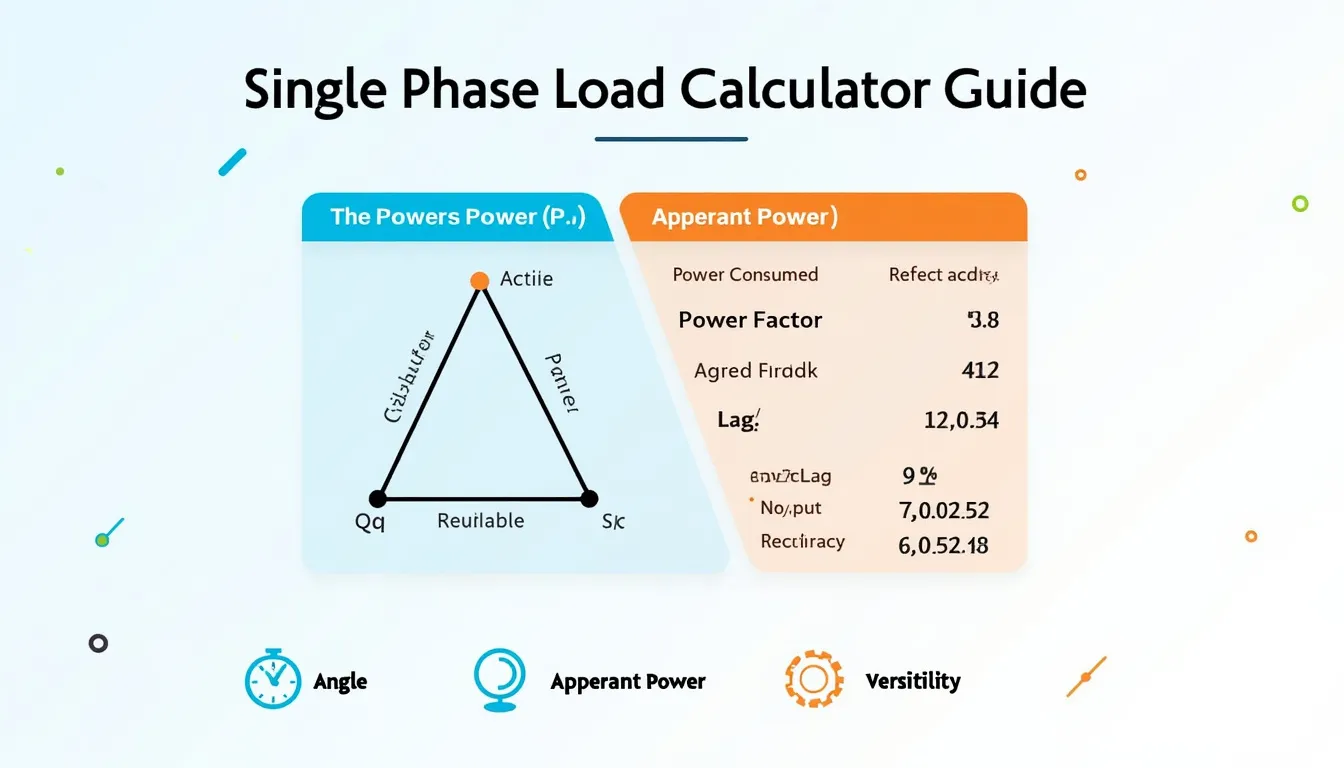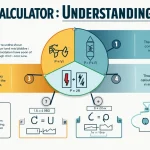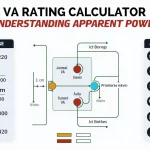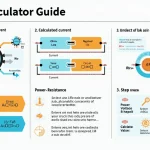Single Phase Load Calculator
Is this tool helpful?
Single Phase Load Calculator: Optimize Your Electrical System Analysis
How to Use the Single Phase Load Calculator Effectively
Our Single Phase Load Calculator is designed to help electrical engineers, technicians, and students analyze single-phase electrical systems quickly and accurately. Follow these steps to make the most of this powerful tool:
- Enter the Power Consumed in kilowatts (kW)
- Input the Power Factor (a value between 0 and 1)
- Select whether the system is Leading or Lagging
- Click the “Calculate” button to get your results
The calculator will then provide you with the following information:
- Angle in radians and degrees
- Apparent Power in VA (Volt-Amperes)
- Reactive Power in VAR (Volt-Amperes Reactive)
Understanding Single Phase Load Calculations
Single phase load calculations are essential for analyzing and designing electrical systems in residential and small commercial applications. These calculations help engineers and technicians determine the power requirements, efficiency, and overall performance of electrical equipment and systems.
The Single Phase Load Calculator utilizes key electrical parameters to provide valuable insights into the behavior of single-phase systems. Let’s explore the fundamental concepts and formulas behind this calculator:
Power Triangle and Power Factor
The power triangle is a graphical representation of the relationship between different types of power in an AC circuit:
$$ S^2 = P^2 + Q^2 $$Where:
- S = Apparent Power (VA)
- P = Active Power (W)
- Q = Reactive Power (VAR)
The Power Factor (PF) is the ratio of active power to apparent power:
$$ PF = \frac{P}{S} = \cos \theta $$Where θ is the phase angle between voltage and current.
Apparent Power Calculation
The calculator determines the apparent power using the following formula:
$$ S = \frac{P}{PF} $$Reactive Power Calculation
Reactive power is calculated using the power triangle relationship:
$$ Q = S \sin \theta $$Benefits of Using the Single Phase Load Calculator
Our Single Phase Load Calculator offers numerous advantages for professionals and students working with electrical systems:
- Time-saving: Quickly perform complex calculations without manual computations
- Accuracy: Minimize human error in calculations
- Versatility: Analyze various single-phase load scenarios
- Educational tool: Helps students understand the relationships between electrical parameters
- Design optimization: Assist in sizing electrical components and systems
- Energy efficiency analysis: Evaluate power factor and its impact on system efficiency
- Troubleshooting aid: Identify potential issues in existing systems
Addressing User Needs and Solving Specific Problems
The Single Phase Load Calculator addresses several common challenges faced by electrical professionals and students:
1. Power Factor Correction
Low power factor can lead to increased energy costs and reduced system efficiency. By calculating the reactive power, users can determine the amount of power factor correction needed to improve system performance.
Example calculation:
- Power Consumed: 5 kW
- Power Factor: 0.7 (lagging)
- Results:
- Angle: -0.7954 rad / -45.57°
- Apparent Power: 7.14 kVA
- Reactive Power: 5.10 kVAR
In this case, the system requires approximately 5.10 kVAR of capacitive reactive power to improve the power factor.
2. System Capacity Planning
The calculator helps users determine the total apparent power required for a given load, which is crucial for sizing transformers, circuit breakers, and conductors.
Example calculation:
- Power Consumed: 15 kW
- Power Factor: 0.9 (leading)
- Results:
- Angle: 0.4510 rad / 25.84°
- Apparent Power: 16.67 kVA
- Reactive Power: 7.26 kVAR
This information allows engineers to select appropriate equipment rated for at least 16.67 kVA to handle the load safely.
3. Energy Efficiency Analysis
By comparing the active power to the apparent power, users can assess the overall efficiency of their electrical system and identify areas for improvement.
Example calculation:
- Power Consumed: 8 kW
- Power Factor: 0.85 (lagging)
- Results:
- Angle: -0.5550 rad / -31.79°
- Apparent Power: 9.41 kVA
- Reactive Power: 4.96 kVAR
In this scenario, the system is operating at 85% efficiency. Improving the power factor could reduce energy losses and lower electricity costs.
Practical Applications of the Single Phase Load Calculator
The Single Phase Load Calculator has numerous practical applications across various industries and scenarios:
1. Residential Electrical System Design
Electrical contractors can use the calculator to properly size the main service panel, circuit breakers, and wiring for new home constructions or renovations. By accurately determining the apparent power and reactive power requirements, they can ensure the electrical system meets the household’s needs while complying with local electrical codes.
2. Industrial Motor Installations
When installing single-phase motors in industrial settings, engineers can use the calculator to determine the total power requirements and assess the impact on the existing electrical infrastructure. This helps in selecting appropriate motor starters, overload protection devices, and power factor correction equipment.
3. Renewable Energy Systems
For small-scale solar or wind power installations using single-phase inverters, the calculator can help determine the proper sizing of the inverter and associated components. By analyzing the power factor and reactive power requirements of the connected loads, system designers can ensure optimal performance and efficiency of the renewable energy system.
4. Commercial Lighting Upgrades
When upgrading lighting systems in commercial buildings, electrical engineers can use the calculator to assess the impact of new LED or fluorescent fixtures on the building’s electrical system. By comparing the power factor and reactive power requirements of the old and new lighting systems, they can determine if any modifications to the existing electrical infrastructure are necessary.
5. Educational Demonstrations
Instructors in electrical engineering and vocational programs can use the Single Phase Load Calculator as a teaching aid to demonstrate the relationships between active power, reactive power, and power factor. Students can experiment with different scenarios to gain a deeper understanding of single-phase electrical systems and power quality concepts.
Frequently Asked Questions (FAQ)
1. What is the difference between leading and lagging power factor?
A leading power factor occurs when the current leads the voltage in an AC circuit, typically due to capacitive loads. A lagging power factor occurs when the current lags behind the voltage, usually caused by inductive loads. The calculator allows you to specify whether the system is leading or lagging to provide accurate results.
2. Why is power factor important?
Power factor is crucial because it affects the efficiency of power transmission and distribution. A low power factor results in higher current flow for the same amount of useful power, leading to increased energy losses, higher electricity bills, and the need for larger electrical equipment.
3. How can I improve my system’s power factor?
To improve power factor, you can add power factor correction devices such as capacitor banks for lagging power factor or reactors for leading power factor. The Single Phase Load Calculator can help you determine the amount of correction needed by calculating the reactive power.
4. Can this calculator be used for three-phase systems?
No, this calculator is specifically designed for single-phase systems. Three-phase systems require different calculations and considerations. We recommend using a dedicated three-phase calculator for such applications.
5. How accurate are the results from this calculator?
The Single Phase Load Calculator provides results based on standard electrical formulas and the input values you provide. However, it’s important to note that we cannot guarantee that the results from our web tool are always correct, complete, or reliable. Our content and tools might have mistakes, biases, or inconsistencies. Always verify critical calculations with multiple sources and consult with a qualified electrical professional when making important decisions.
Conclusion: Empowering Electrical Analysis with the Single Phase Load Calculator
The Single Phase Load Calculator is an invaluable tool for anyone working with electrical systems, from students and hobbyists to professional engineers and technicians. By providing quick and accurate calculations of key electrical parameters, this calculator empowers users to:
- Optimize power factor and improve energy efficiency
- Properly size electrical components and systems
- Analyze and troubleshoot existing installations
- Make informed decisions in electrical system design and upgrades
- Enhance understanding of single-phase electrical concepts
Whether you’re designing a new electrical system, upgrading existing infrastructure, or simply learning about power quality concepts, the Single Phase Load Calculator offers a user-friendly and powerful solution to streamline your work and improve your results.
Take advantage of this free, easy-to-use tool to enhance your electrical calculations and analysis. Start using the Single Phase Load Calculator today and experience the benefits of quick, accurate, and insightful electrical system analysis at your fingertips!
Important Disclaimer
The calculations, results, and content provided by our tools are not guaranteed to be accurate, complete, or reliable. Users are responsible for verifying and interpreting the results. Our content and tools may contain errors, biases, or inconsistencies. We reserve the right to save inputs and outputs from our tools for the purposes of error debugging, bias identification, and performance improvement. External companies providing AI models used in our tools may also save and process data in accordance with their own policies. By using our tools, you consent to this data collection and processing. We reserve the right to limit the usage of our tools based on current usability factors. By using our tools, you acknowledge that you have read, understood, and agreed to this disclaimer. You accept the inherent risks and limitations associated with the use of our tools and services.







